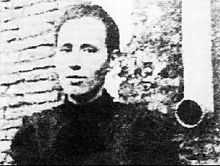Virginia Bolten
| Virginia Bolten | |
|---|---|
 Photo of Virginia Bolten | |
| Born |
1870 San Luis, Argentina or possibly San Juan |
| Died |
1960 Montevideo, Uruguay |
| Known for | publishing anarchist newspapers, organizing first May Day demonstration in South America |
Virginia Bolten (1870–1960) was an anarchist of German descent. A gifted orator,[1][2] she originally lived in Argentina, before she was deported to Uruguay in 1902.
Biography
Virginia Bolten, the daughter of a German emigrant, was born in 1870 in Argentina, either in San Luis or San Juan. She spent her childhood in San Juan, a province of Argentina. After reaching adulthood she worked as a shoemaker and a sugar factory worker. While working as a shoemaker she met Juan Marquez, an organiser of a shoe workers union, whom she later married.[3] Instrumental in her introduction to anarchist circles was her acquaintance with Pietro Gori.[4] After a number of years of activity in the feminist, anarchist, and workers' movements, she was deported to Uruguay under the Residence Law in 1902.[1][5]
Activism
In 1888 Bolten became one of the publishers of The Working Baker of Rosario (Spanish: El Obrero Panadero de Rosario), one of the first anarchist newspapers in Argentina. In 1889 she organized the seamstresses' demonstration and consequent strike in Rosario, probably the first strike by female workers in Argentina.[3][6]
In 1890 Virginia Bolten, Romulo Ovidi and Francisco Berri were the main organizers of the first May Day demonstrations. The other editors of The Working Baker of Rosario had an equally important role in the organization of the demonstrations.[3] On April 30, 1890 (the day before the demonstrations), she was detained and interrogated, by local police forces, for distributing leaflets outside the major factories of the area. During the May Day demonstrations she led a group of thousands of workers who were marching to Plaza Lopez, the main square of Montevideo, the capital city of Uruguay. Throughout the march she carried the red flag, on which was written "First Of May - Universal Fraternity" (Spanish: Primero de Mayo - Fraternidad Universal; Los trabajadores de Rosario cumplimos las disposiciones del Comité Obrero Internacional de París).[7][8]
La Voz de la Mujer
Bolten is probably responsible for the publication of a newspaper called La Voz de la Mujer (English: The Woman's Voice), which was published nine times in Rosario between 8 January 1896 and 1 January 1897, and was revived, briefly, in 1901. A similar paper with the same name was reportedly published later in Montevideo, which suggests that Bolten may also have founded and edited it after her deportation.[1]
La Nueva Senda
In Uruguay, Bolten continued her activism, publishing a newspaper called La Nueva Senda (English: The New Path) from 1909 to 1910.[9]
Other publications
She published many articles in anarchist-communist journals and newspapers, the most notable of which were La Protesta and La Protesta Humana.
Legacy
Park
Puerto Madero, a district of Buenos Aires, named a park in her honor.[10]
Film
In 2007 the government of the San Luis Province in Argentina decided to fund a film honoring Virginia Bolten.[11] The film focuses mainly on Bolten's life, anarchist feminism and the social conditions, which led to the publication of La Voz de la Mujer. It is titled No god, No master, no husband (Spanish: Ni dios, ni patrón, ni marido) after one of the newspaper's mottos[11] and Virginia Bolten is played by Julieta Díaz. The film, which will be released on April 29, 2010, in Argentina, was directed by the Spanish director Laura Mañá.[12]
References
- ↑ 1.0 1.1 1.2 Molyneux, Maxine (2001). Women's movements in international perspective: Latin America and beyond. Palgrave MacMillan. p. 24. ISBN 978-0-333-78677-2.
- ↑ Moya, José (2002). "Italians in Buenos Aires's Anarchist Movement: Gender Ideology and Women's Participation, 1890-1910". In Donna R. Gabaccia, Franca Iacovetta. Women, gender and transnational lives: Italian workers of the world. U of Toronto P. pp. 195, 205. ISBN 978-0-8020-8462-0. Retrieved 2 February 2010.
- ↑ 3.0 3.1 3.2 "Biography of Virginia Bolten". Retrieved 2 February 2010.
- ↑ Carlson, Marifran (1988). Feminismo!: the woman's movement in Argentina from its beginnings to Eva Perón. Academy Chicago Publishers. p. 127. ISBN 978-0-89733-152-4.
- ↑ Molyneux, Maxine; Jaqueline Cruz (trans.) (2003). Movimientos de mujeres en América Latina: estudio teórico comparado (in Spanish). Universitat de València. p. 42. ISBN 978-84-376-2086-2. Retrieved 2 February 2010.
- ↑ Moya, José (2002). "Italians in Buenos Aires's Anarchist Movement: Gender Ideology and Women's Participation, 1890-1910". In Donna R. Gabaccia, Franca Iacovetta. Women, gender and transnational lives: Italian workers of the world. U of Toronto P. p. 202. ISBN 978-0-8020-8462-0. Retrieved 2 February 2010.
- ↑ Portugal, Ana Maria (8 March 2005). "Anarquistas: “Ni Dios, Ni Patrón, Ni Marido”" (in Spanish). Mujeres Hoy. Retrieved 2 February 2010.
- ↑ "Museo de la Ciudad" (in Spanish). Retrieved 2 February 2010.
- ↑ Ehrick, Christine (2005). The shield of the weak: feminism and the State in Uruguay, 1903-1933. UNM Press. p. 61. ISBN 978-0-8263-3468-8. Retrieved 2 February 2010.
- ↑ "Argentina: Caputo, Salvatori associate". South American Business Information. 6 December 2000. Retrieved 2 February 2010.
- ↑ 11.0 11.1 "Film Adaptation of Virginia Bolten's activities" (in Spanish). Argentina: Pagina 12. October 3, 2007. Retrieved 2 February 2010.
- ↑ "Ni dios, ni patrón, ni marido". Retrieved 2 February 2010.